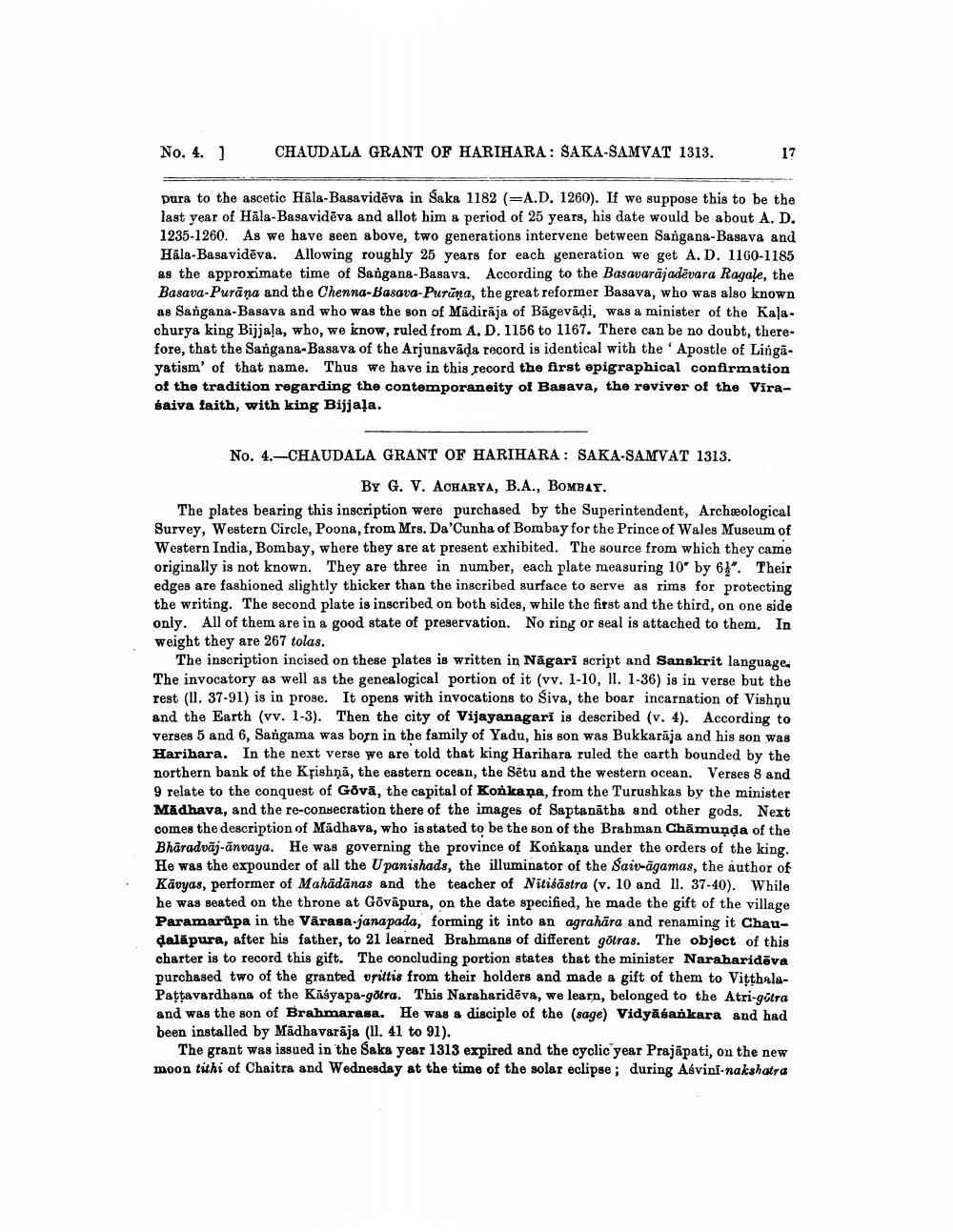________________
No. 4. ]
CHAUDALA GRANT OF HARIHARA: SAKA-SAMVAT 1313.
17
para to the ascetic Hāla-Basavidēva in Saka 1182 (=A.D. 1260). If we suppose this to be the last year of Hāla-Basavidēva and allot him a period of 25 years, his date would be about A. D. 1235-1260. As we have seen above, two generations intervene between Sangana-Basava and Häla-Basavidēva. Allowing roughly 25 years for each generation we get A.D. 1100-1185 as the approximate time of Sangana-Basava. According to the Basavarājadēvara Ragale, the Basava-Purāna and the Chenna-Basava-Purūna, the great reformer Basava, who was also known as Sangana-Basava and who was the son of Mādirāja of Bägevādi, was a minister of the Kalachurya king Bijjala, who, we know, ruled from A.D. 1156 to 1167. There can be no doubt, there. fore, that the Sangana-Basava of the Arjunavāda record is identical with the 'Apostle of Lingayatism' of that name. Thus we have in this record the first epigraphical confirmation of the tradition regarding the contemporaneity of Basava, the reviver of the Virasaiva faith, with king Bijjaļa.
No. 4.-CHAUDALA GRANT OF HARIHARA : SAKA-SAMVAT 1313.
By G. V. ACHARYA, B.A., BOMBAY. The plates bearing this inscription were purchased by the Superintendent, Archäological Survey, Western Circle, Poona, from Mrs. Da'Cunha of Bombay for the Prince of Wales Museum of Western India, Bombay, where they are at present exhibited. The source from which they came originally is not known. They are three in number, each plate measuring 10" by 6)". Their edges are fashioned slightly thicker than the inscribed surface to serve as rims for protecting the writing. The second plate is inscribed on both sides, while the first and the third, on one side only. All of them are in a good state of preservation. No ring or seal is attached to them. In weight they are 267 tolas.
The inscription incised on these plates is written in Nāgari script and Sanskrit language. The invocatory as well as the genealogical portion of it (vv. 1-10, 11. 1-36) is in verse but the rest (II. 37-91) is in prose. It opens with invocations to Siva, the boar incarnation of Vishnu and the Earth (vv. 1-3). Then the city of Vijayanagari is described (v. 4). According to verses 5 and 6, Sangama was born in the family of Yadu, his son was Bukkarāja and his son was Harihara. In the next verse we are told that king Harihara ruled the carth bounded by the northern bank of the Kpishņā, the eastern ocean, the Sētu and the western ocean. Verses 8 and 9 relate to the conquest of Govă, the capital of Konkana, from the Turushkas by the minister Madhava, and the re-consecration there of the images of Saptanātha and other gods. Next comes the description of Madhava, who is stated to be the son of the Brahman Chāmunda of the Bhāradvāj-anvaya. He was governing the province of Konkaņa under the orders of the king. He was the expounder of all the Upanishads, the illuminator of the Saiv-āgamas, the author of Kavyas, performer of Mahädānas and the teacher of Nitiśāstra (v. 10 and 11. 37-40). While he was seated on the throne at Gövāpura, on the date specified, he made the gift of the village Paramarüpa in the Värasa-janapada, forming it into an agrahāra and renaming it Chaudalāpura, after his father, to 21 learned Brahmans of different götras. The object of this charter is to record this gift. The concluding portion states that the minister Naraharidēva purchased two of the granted upittis from their holders and made a gift of them to VitthalaPattavardhana of the Kāsyapa-gðtra. This Naraharidēva, we learn, belonged to the Atri-götra and was the son of Brahmarasa. He was a disciple of the (sage) Vidyasankara and had been installed by Madhavarāja (l. 41 to 91).
The grant was issued in the Saka year 1313 expired and the cyclic year Prajāpati, on the new moon tithi of Chaitra and Wednesday at the time of the solar eclipse; during Asvini- nakshatra




